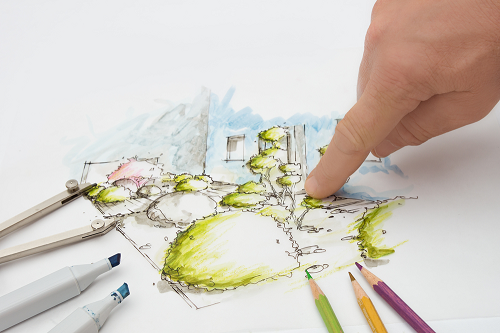4 Basic Principles of Garden Design
To get the most out of your garden design, you need to know some basic principles of landscaping. By paying attention to the principles, you’ll increase your creativity and generate new ideas for a unique effect. The best thing is that these guidelines are neither fussy nor constraining. If you have an eye for detail, you’ll quickly end up with a more successful and eye-catching California garden design.
1. Generous Use of Color
Color brings the dimension of life to your garden design. Warm colors like red, orange, and yellow tend to bring objects closer to you. Cool colors like blues and greens are effective in moving things away from you.
A balanced combination of both warm and cool colors can help create perspective in your design. They work well for both plants and hardscape to bring out a particular mood. In garden design, weave colors intricately throughout the design composition for a more balanced look. Remember to extend the presence of color across the seasons at various levels.

2. Lines are Important in Garden Design
The concept of regulating lines is essential in garden design. An architecture element, like a building edge or door, can create an imaginary line to help connect and organize your layout. They are essential in helping you control movement, accentuate an object, or draw attention to a focal point.
For example, a garden path or walkway leading to an area of interest will naturally direct a person to that object. On the contrary, a meandering walkway will create a feeling of uncertainty or surprise.
Lines can be vertical, diagonal, curved, or straight and may either be real or implied. The latter is created from a series of objects aligned in a way that makes them look like they are in a line. This effect is common in designs that use plant forms to imply a line. The use of lines to regulate the garden design spells the difference between professional and amateur design.
3. Bring Out Texture in Your Design
In gardening, the use of texture is common to achieve a fantastic curb appeal. Texture falls into three different categories, namely, fine, medium, and coarse. For example, the texture of pavements differs from that of plants and other elements. Contrasting textures can add an exciting feature to design composition.
The texture of plants in gardening refers to the overall presence of the plants. In general, plants have two texture types, namely, bold and soft. Bold textures tend to attract more attention. They are those plants that reach great heights and come with large, impressive foliage.
Plants with soft textures have a less visual impact as they have small and delicate foliage. They may not make a statement in the garden immediately, but they effectively offer a whimsical appearance, serving as a vital aspect of the garden.
4. Unity in Your Overall Design
The three principles above are not complete without unity. In this case, unity refers to the repetition, balance, harmony, and consistency of a design. Consider repeating elements like plants, color, and decor in the landscape. Consistency is crucial as it helps you achieve unity by bringing together different landscaping elements to create a common theme.
Don’t forget to balance your design, either symmetrically or asymmetrically. In symmetrical balance, two sides of your design look similar, while asymmetrical balance is more about using different objects and elements to achieve balance. They, however, must have almost identical imaginary weight, size, and shape.
Final Thoughts
With these four principles of garden design, you can creatively unleash your landscaping prowess. Utilizing color combinations, lines, and textures, you will end up with a unified design of your landscape. If you need professional help in your garden design venture, reach out to us for expert guidance.
Both comments and pings are currently closed.





